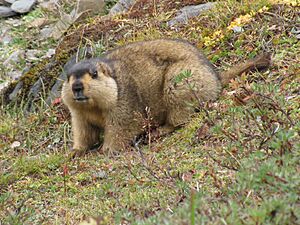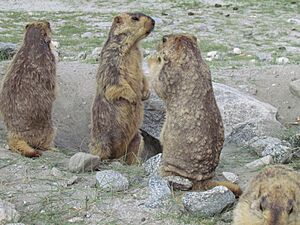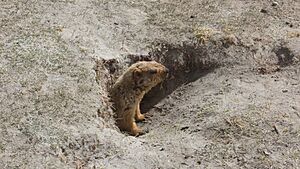Himalayan marmot facts for kids
Quick facts for kids Himalayan marmot |
|
|---|---|
 |
|
 |
|
| Individual at Tshophu Lake, Bhutan (above), group with worn pelage in Ladakh, India (below) | |
| Conservation status | |
| Scientific classification | |
| Genus: |
Marmota
|
| Species: |
himalayana
|
The Himalayan marmot (Marmota himalayana) is a type of marmot. These furry animals live in the high mountain grasslands of the Himalayas and on the Tibetan Plateau. Scientists say it is a "Least Concern" species. This means it is not in danger of disappearing. There are many of them, and they live in a very large area.
Contents
Discovering the Himalayan Marmot
In 1841, a scientist named Brian Houghton Hodgson first described the Himalayan marmot. He gave it the scientific name Arctomys Himalayanus. Over time, other scientists found more marmots. They thought some of these might be different types, or subspecies, of the Himalayan marmot.
The Himalayan marmot is closely related to the Tarbagan marmot. It is also related to the black-capped marmot, but they look a bit different. These three marmots are like a family group. Their next closest relatives are the bobak marmot and other similar marmots.
What Does a Himalayan Marmot Look Like?
The Himalayan marmot has thick, woolly fur. Its back is reddish-grey. Its ears, belly, and legs are yellowish-red. The tip of its nose and tail are dark brown.
It is one of the biggest marmots in the world. It is about the size of a large housecat. These marmots weigh between 4 and 9.2 kilograms (9 to 20 pounds). They are lightest in spring after hibernation. They are heaviest in autumn, before they go to sleep for winter. In autumn, they can weigh over 7 kilograms (15 pounds). A Himalayan marmot is about 45 to 67 centimeters (18 to 26 inches) long. Its tail is about 12 to 15 centimeters (5 to 6 inches) long.
Where Do Himalayan Marmots Live?
Himalayan marmots live in the Himalayas and on the Tibetan Plateau. They are found at very high altitudes, from 3,000 to 5,500 meters (9,800 to 18,000 feet). You can find them in places like northeastern Pakistan, northern India, Nepal, Bhutan, and China.
In China, they live in several provinces, including Xinjiang and Qinghai. They live in short grassy areas or alpine habitats. These are usually above the tree line, where trees cannot grow. But they live below the permanent snow line.
How Himalayan Marmots Live
Himalayan marmots live in groups called colonies. They dig deep burrows, which are like underground tunnels. All the marmots in a colony share these burrows during hibernation. They hibernate from late autumn to early spring, for about 7 and a half months.
Their burrows can be 2 to 10 meters (7 to 33 feet) deep. This is possible when the soil is light and deep enough. In places with ideal soil, a marmot colony can have up to 30 families. About 10 families might live in an area of 1 square kilometer (0.4 square miles).
Marmots eat plants that grow in pastures. They especially like the soft, juicy parts of grasses. They also eat flowering plants like Gentiana and Taraxacum (dandelions).
Life Cycle of the Himalayan Marmot
Female marmots can have babies when they are two years old. After being pregnant for about one month, they give birth. A mother marmot can have anywhere from 2 to 11 young marmots in one litter.
Who Hunts the Himalayan Marmot?
On the Tibetan plateau, marmots are food for animals like the snow leopard. Other animals that hunt Himalayan marmots include Tibetan wolves and red fox. Large birds of prey also hunt them. These birds include hawks, kestrels, bearded vultures, and golden eagles.
Himalayan Marmots in Culture
Ancient Greek writers knew about these marmots. They called them "gold-digging ants." This might be because gold nuggets were found in the dirt dug up by these marmots. A French scientist named Michel Peissel thought the story of "gold-digging ants" by the Greek historian Herodotus was about the golden Himalayan marmots. He believed local tribes collected gold dust from their burrows.
In 2019, a photo of a Himalayan marmot being hunted by a Tibetan fox won a big award. The picture, taken by Bao Yongqing, won the overall prize in the Wildlife Photographer of the Year award.
See also





